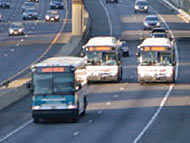3/24/2008
Virginia Toll Roads to Fund Bus, Rail Not RoadsToll road revenue in Northern Virginia will be used to subsidize bus and rail not improve local roads.

Although described as "user fees," motorists who pay expected tolls to use existing lanes on Interstates 95 and 395 in Virginia will not be paying for improved road maintenance or new road capacity anywhere in Northern Virginia under proposals expected to begin construction later this year. Instead, motorists taxed to drive on existing lanes will find their money used to subsidize new buses, "enhance 12 existing bus stations," and improve rail service in the city of Fredericksburg.
The Virginia Department of Transportation (VDOT) last year entered an agreement with Fluor-Transurban, a company that will construct, operate and provide routine maintenance for "High Occupancy Toll" lanes constructed on existing high occupancy vehicle (HOV) lanes on I-95/395. Vehicles with three or more passengers would continue to use the lanes for free, but single passengers could pay a variable toll to buy their way in. To keep the complex system running, a $50 million infrared tolling camera system would scan every passing vehicle and image both the driver and passengers. When the computer believes fewer than three people are on board and a toll has not been paid, a ticket will be sent in the mail.
Private investors will contribute $135 million to the project, expecting a 12.5 percent return on their money. The project construction will cost motorists a total of $913.4 million -- before cost-overruns. Another $390 million in motorist payments will subsidize mass transit options. Fluor-Transurban also offered VDOT a $250 million "concession payment" to earn the agency's approval for the deal.
Toll prices to use the lane will vary depending on the amount the public is willing to spend. A similar tolling system on State Route 91 in Southern California charges more than $10 to travel less than ten miles. A High Occupancy Tolling project on the Capital Beltway is expected to open in 2013 while the I-95/395 project is expected to take four to five years to complete.


